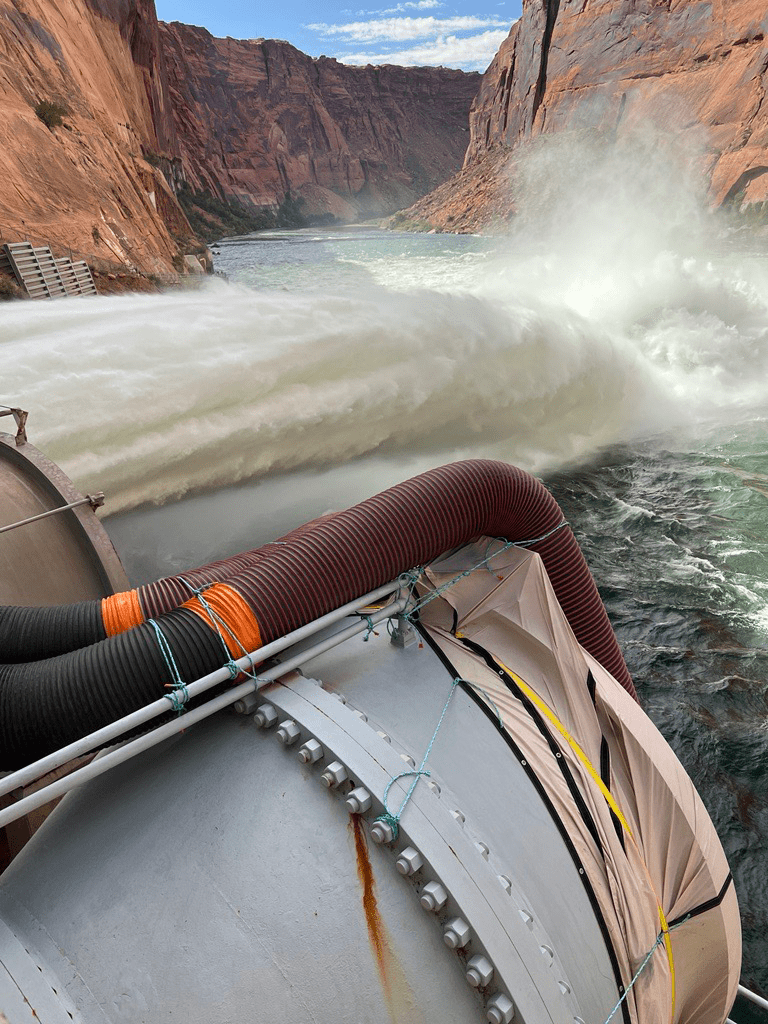- $8.9 million investment from the Bipartisan Infrastructure Law is invested.
- Relining of four river outlet works at Glen Canyon Dam is underway.
- Project expected to take one year to complete.
September 6, 2024 — On Tuesday, the Bureau of Reclamation announced the start of a major project to reline the river outlet works at Glen Canyon Dam. Funded by an $8.9 million investment from the Bipartisan Infrastructure Law, the project aims to ensure the dam’s ability to provide efficient and reliable water delivery for years to come.
Aging Infrastructure.
The dam’s outlet works, also known as bypass tubes, consist of four steel pipes that directly move water from Lake Powell into the Colorado River, bypassing the hydro-power generating units. The original coal-tar coating lining these pipes is over 60 years old and showing signs of wear and tear, necessitating replacement.
The project involves removing the old lining and applying a new epoxy primer and polysiloxane topcoat using a robotic sprayer. This advanced lining system has been rigorously tested and successfully implemented in other dams, including Fontana, Pineview, and Grand Coulee.
Ensuring Future Water and Energy Needs.
“It is Reclamation’s duty and obligation to operate all of our facilities – including Glen Canyon Dam – in a safe manner and to maintain reliable downstream releases to meet the nation’s water and energy needs,”said Wayne Pullan, Reclamation’s Upper Colorado Basin Regional Director . “The relining of the outlets ensures Glen Canyon Dam continues to operate in a manner that meets its congressionally authorized purposes safely and efficiently well into the future.”
. “The relining of the outlets ensures Glen Canyon Dam continues to operate in a manner that meets its congressionally authorized purposes safely and efficiently well into the future.”
Mitigating Risks at Low Water Levels.
In April 2024, Reclamation released a memo detailing potential risks to Glen Canyon Dam’s water release infrastructure if Lake Powell’s water levels drop too low for power generation. The dam relies on underwater outlet works (steel tubes) to release water in such scenarios. The memo highlighted the significant risk of damage if these tubes are used for extended periods.
To mitigate these risks, Reclamation plans to make maintenance and operational improvements to the dam. This includes potential repairs to the outlet works starting in late 2024 or early 2025. The current relining project is part of this broader effort to ensure the dam’s resilience in the face of declining water levels.
Increased Use of Outlets.
Glen Canyon Dam impounds Lake Powell, the second-largest man made reservoir in the United States and the largest storage unit in the Upper Colorado Basin. Historically, the dam’s outlets have been used infrequently, with water primarily released through penstocks for hydro-power generation. However, the outlets are utilized more often with lower lake levels. This increased usage and the potential for even greater reliance on the outlets during future droughts has made this maintenance project a top priority.
~~~
Image from the Bureau of Reclamation’s news release: A robotic sandblaster is removing the original coating inside the covered river outlet work that is pictured here. The original coal-tar coating is more than 60 years old and will be replaced with an epoxy primer and polysiloxane topcoat. All four outlets at Glen Canyon Dam will be relined over the next year. Currently, the relining work is overlapping with cool-mix flows, which involves releasing water from both the penstocks and river outlets to send cooler water downstream and disrupt the spawning of non-native fish.


Leave a Reply